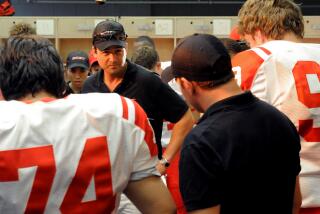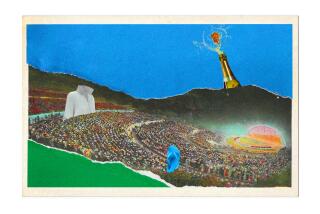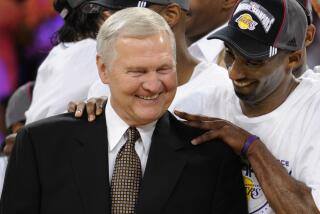Inspiration Points
It was a shot that inspired millions, as well as a popular American movie, a shot that had Indianans believing in miracles long before Al Michaels posed his famous question.
Fifty years ago, Bobby Plump stood on the basketball court inside Butler Fieldhouse, at the edge of the foul line, and made the jump shot that lifted tiny Milan High (enrollment: 161) to victory over Muncie Central for the 1954 Indiana state high school basketball championship. The ball swished through the hoop half a century ago but, in a sense, it has never stopping bouncing, its impact still reverberating today.
The shot and the upset christened Plump as an Indiana sports icon, made Milan (pronounced My-lon) an everlasting role model for seemingly hopeless underdogs and provided the imaginative fodder for the 1986 movie âHoosiers.â
Marking the 50th anniversary of the legendary game, ESPN Classic will show the 1954 Milan-Muncie Central final in its entirety, beginning at 3 p.m. Saturday, followed by a live telecast of a game between the current Milan and Muncie varsities, starting at 4:30 p.m. Plump, along with members of both â54 finalists, will be honored at the game.
Fifty years. âHard to believe,â said Plump, now a 67-year-old business executive living in Indianapolis. âExcept when I play ball on Thursday night and guys tell me they donât see any daylight under my shoes when I jump. And I know Iâm jumping.â
Yes, America, Bobby Plump still plays basketball.
âPlay -- I use that word loosely,â he said with a laugh. âItâs half-court. You have to be over 50. You get tired, you sit down, you know? But itâs fun.â
In âHoosiers,â the Jimmy Chitwood character was based on Plump, again, quite loosely.
âI did not hold out,â Plump said, pointing out the first significant difference between real life and the movie. âI thought it was such an honor to have a uniform. I remember being in grade school and the county tourney was held in Milan and weâd go to those games. I remember thinking, âBoy, just give me a uniform and let me sit on the bench and my life will be complete.â â
Plump also said he âdidnât save the coachâs job.â
He laughed again.
âWell, I might have saved the coachâs job by winning the tournament, but nothing like what happened in the movie.â
In the movie, Gene Hackman plays Norman Dale, a 50ish former college coach fired for punching a player and searching for another chance, a last chance, at little Hickory High, a fictional Indiana high school fashioned after Milan.
In real life, the 1954 Milan Indians were coached by Marvin Wood, who âwas 24 years old when he came to Milan,â according to Plump. âThey had fired our coach at the end of our sophomore season. Marvin Wood was 24, married, had two children, never raised his voice. He was a quiet-spoken individual. If he just raised it a little bit, you knew he meant business. Iâve never heard the man cuss in my life....
âHe was quite different [from Dale]. When youâre 24 years old, itâs probably not your last opportunity to come in and save yourself, right?
âBut I loved Gene Hackman and his character. That was a great touch.â
Angelo Pizzo, who wrote and co-produced âHoosiers,â said, âOur coach and our story were so different. Marvin and his wife are such sweet people, such good people. Marvin didnât even think about slugging a player. The idea is beyond comprehension.â
In fact, Pizzo said he declined to use Wood as a consultant on the film out of deference to the coach, who died in 1999.
âI didnât want to hurt his feelings by doing that story and, basically, doing it my way,â he said. âI didnât know him and didnât know if he would take umbrage at what we were doing.â
Pizzo grew up in Indiana, as did âHoosiersâ director David Anspaugh. Pizzo and Anspaugh were fraternity brothers at Indiana University, were both interested in film, and often discussed which movies they would most like to see made. The âMilan Miracleâ was high on their list.
Pizzo remembers outlining the plot during class at USCâs film school.
âIt got a withering review,â he said. âThey said, basically, âItâs a cliche story, David and Goliath, weâve seen it a hundred times. Thereâs nothing unique about it, itâs really boring and you are suffering from the myth of primary experience. Just because you experienced it and you enjoyed it doesnât mean anybody else will.â â
Pizzo said he âsort of filed it awayâ for a while, unearthing it after he had established some footing in the film industry and became vice president of production for Time-Life Films.
âWhat I found was interesting about it was not the little team that could,â Pizzo said, âbut the unique fabric of basketball in Indiana -- how itâs interwoven with the culture, and the meaning and importance of basketball. And I particularly was drawn to the time as well. The early â50s have always interested me because, I suppose, it was the last era or last period of true regionalism, before television sort of homogenized the consciousness, the language of the subcultures of America.
âWhen I did research on it, it did verify my feelings about it. When these kids went to Indianapolis to play in the state finals, many of them had not seen buildings taller than two stories. It was like a foreign country, almost, a foreign city. So it just felt like it was an interesting topic, an interesting area and subject and, certainly, story.â
Pizzoâs research included an interview with Gene White, a member of the 1954 Milan team.
âI knew from working on films that the essence of all drama is conflict,â he said. âSo I asked him if everybody got along. He said, âYep, everybody got along.â
âI asked, âHow about Coach, did he have any difficulty being the new guy coming in?â
âHe said, âNope, everybody liked him.â
âI said, âWas there any troublemaker, anybody who just did anything that was not by the rules?â
âAnd he said, âWell, Bobby Plump did show up late for practice every once in a while and they made him run laps.â
âAnd I knew I didnât have a movie. I knew I was dead in the water. That would have been the most boring story of all time.â
Then Pizzo decided to fictionalize his script. He invented characters, created subplots, changed the name of the school and the year. Milan won the Indiana state championship in the 1953-54 season. Hickory wins the title in âHoosiersâ during the 1951-52 season.
Among Pizzoâs contrivances was âShooter,â the alcoholic assistant coach played by Dennis Hopper.
âWe did not have an alcoholic sitting on the bench,â Plump said. âWe did have a player who grew up in an alcoholic family, but Angelo didnât know anything about that.â
Pizzo said he wrote the part for Harry Dean Stanton, but Stanton turned it down.
âI saw [Stanton] later,â Pizzo said, âand he said he fired his agent after Dennis got an Academy Award nomination. He said he never read it. Anyway, it doesnât matter.... Within three minutes of talking to [Hopper], we knew he was the guy.â
Some other differences:
* In the movie, the Hickory Huskers come out of nowhere to play in the state final. In real life, Milan had reached the final four in 1953, Plumpâs junior season and Woodâs first with Milan. A year later, Milan returned to the final four with a playoff-seasoned team and won it all.
* In the movie, Dale brings his awestruck players into massive Butler Fieldhouse and has them measure the key and the height of the basket to show that the dimensions are just the same as back home. Plump said, âWe never measured the goal,â but remembers Wood bringing the Milan team to the same arena in 1953.
âEverybody just stopped and looked around and it got real quiet,â he said. âAnd Bob Engel, one of the players on our team, said, âYou could put a lot of hay in this place, couldnât you?â And that kind of broke the tension.â
* In the movieâs final game, Hickory rallies to beat South Bend Central on Chitwoodâs last-second shot, 42-40. In the 1954 final, Milan ran a stall in the second half, resulting in Plumpâs standing with the ball on his hip for 4 minutes 15 seconds during the fourth quarter ... with Muncie leading, 28-26. Milan eventually tied the score and won on Plumpâs last-second shot, 32-30.
After the game, Plump said reporters âasked Marvin Wood, âCoach, what was in your mind? Youâve got that Plump kid standing out there for 4 minutes and 15 seconds in the most important game of your life and youâre down, 28-26?â And Wood said, âI was trying to think of something to do.â â
Plump first saw âHoosiersâ at a sneak preview in Indianapolis. After the viewing, Pizzo saw Plump and asked for a review.
âHe called me aside and said, âBobby, Iâve got two questions. Whatâd you think of the movie?â I said, âAngelo, I loved it. I thought it was a great movie. I laughed, I cried. I felt good when it was over.â
âAnd he said, âDid we get the last 18 seconds right?â He wanted that to be exactly the way it occurred. And it is, exactly, after the ball is thrown in.
âThatâs really the only factual thing in the movie. The rest of it are similarities.â
No one associated with the 1954 Milan team received any sort of payments or royalties from the movie.
âThere wasnât anything at all,â Plump said. âThere wasnât a reference to Milan. They kept away from the names of the players and the town and so forth. There was no money that changed hands to any of the players.â
That is, except for Ray Craft, a guard on the 1954 team, who had a bit part in the film as an official who welcomes the Hickory squad to Butler Fieldhouse.
Today, Plump runs a life insurance and consulting business, Bobby Plump and Associates, and owns an Indianapolis restaurant called, of course, âPlumpâs Last Shot.â The menu features a âPlump Burger,â stuffed potato âPlumpskinsâ and, in keeping up with the times, a âMilan Wrap,â available with or without meat.
Former teammate White had kidded Plump that the restaurant ought to be called âPlumpâs Lucky Shot.â
âIt was the worst game I played in two years of tournament play,â Plump said of the 1954 final.
Perhaps as a consequence, Plump estimates he has watched the game film only âsix or seven timesâ in 50 years.
Plump maintains there is another reason why he has shied away from the footage.
âIâm afraid that shot wonât go in,â he said, âand the dream will be over.â
More to Read
Get our high school sports newsletter
Prep Rally is devoted to the SoCal high school sports experience, bringing you scores, stories and a behind-the-scenes look at what makes prep sports so popular.
You may occasionally receive promotional content from the Los Angeles Times.






